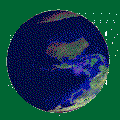African Civet (Civettictis civetta)

×


About African Civet (Civettictis civetta)
- Kingdom: Animals
- Phylum: Chordates
- Class: Mammals
- Order: Carnivorans
- Family: Viverridae
The African civet is a large viverrid native to sub-Saharan Africa, where it is considered common and widely distributed in woodlands and secondary forests. It is listed as Least Concern on the IUCN Red List since 2008. In some countries, it is threatened by hunting, and wild-caught individuals are kept for producing civetone for the perfume industry.
Source: Wikipedia
Visits
-
2001-06-30
South Luangwa National Park, Zambia -
2011-01-07
Nechisar National Park, Ethiopia

